Sigma In Velociraptor
This page discusses how Sigma is implemented and used within Velociraptor.
What is Sigma?
Detection engineering is an evolving field with many practitioners developing and evolving signatures rapidly, as new threats emerge and better detection capabilities are introduced. However, much of the time the specifics of how to write detection rules depend on the underlying software and detection engine. For example, a particular detection rule written to work on Elastic based SIEM is not easy to port to a different platform (e.g. Splunk).
Sigma is an attempt to abstract away the specifics of the detection
engine into a generic high level signature description. The Sigma Rule, theoretically, does not target a specific detection product,
but instead described high level concepts like process execution,
registry access etc.
By providing a high level taxonomy for practitioners, detection rules can be exchanged with others in the community, even people using different backend detection engines.
Traditionally, a Sigma rule is not directly usable by many backend
detection engines. Instead a Sigma Compiler transforms the Sigma
rule to a specific query in the backend’s native query language. For
example a Sigma rule may be “compiled” into an Elastic Query, or
Splunk Query as needed.
While the full details of Sigma are described in the Main Sigma page https://sigmahq.io/ , in this post we will discuss as a high level those aspects of Sigma directly relevant to the Velociraptor implementation.
How is Sigma used traditionally?
Sigma was designed to write detection rules for traditional SIEM based detection engines.
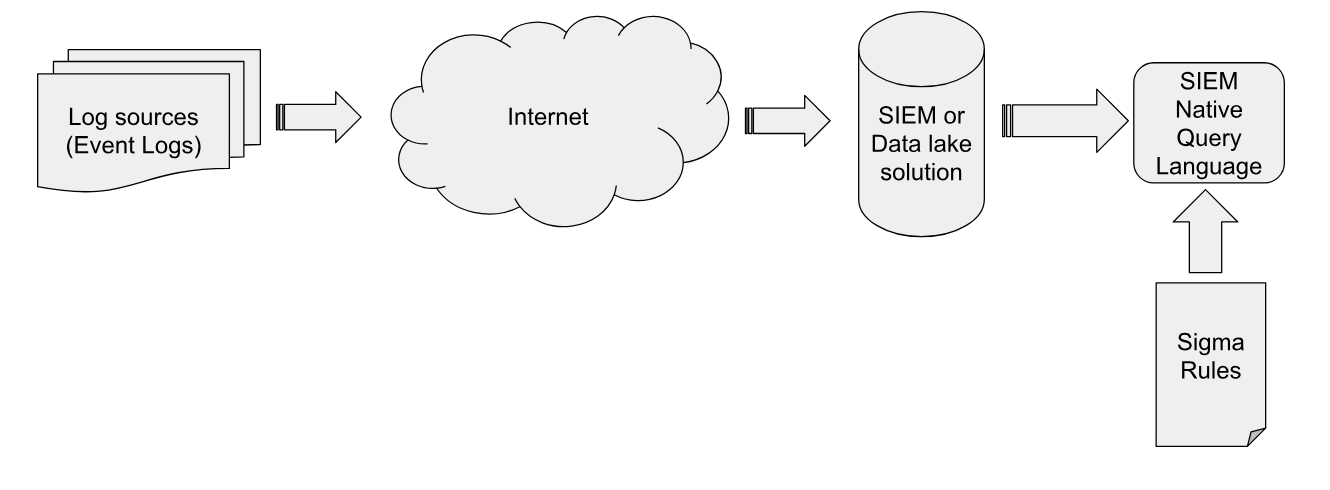
Such a system is shown above:
- Log Sources like event logs are collected by an endpoint agent
- Events are forwarded over the network to a SIEM or central data lake solution.
- Sigma Rules are compiled into native queries against the SIEM solution
- The SIEM or data lake implementation uncovers detections based on this query.
In practice, each SIEM product has a unique way of normalizing the
available data to fit within their own database schema. For example
the Elastic ecosystem uses the Elastic Common Schema
(ECS). The
ECS schema converts from certain fields in the original event log file
to different field names within the ECS - for example the field
System.TimeCreated.SystemTime in the event log file is translated to
the field @timestamp by the Elastic agent for storage in the database.
It is often hard to know exactly what the translation is supposed to be because vendors attempt to normalize many different log sources to the same schema. In the case of ECS the reference documentation is incredibly vague and we need to resort to reading the code to figure out the exact field mappings to understand exactly where each field is gathered from. Additionally, this translation is not always a simple renaming, but sometimes involves a non-trivial transformation by the Elastic agent which is not always well documented.
The Sigma rule
Sigma is designed to be a high level abstracted notation that can cater for the differences between the backends. This is achieved by defining yet another layer of abstraction over the original events. Consider the following reduced Sigma rule (The full rule here):
title: Scheduled Task Executed Uncommon LOLBIN
logsource:
product: windows
service: taskscheduler
detection:
taskscheduler:
Channel: Microsoft-Windows-TaskScheduler/Operational
selection:
EventID: 129
Path|endswith:
- \calc.exe
- \cscript.exe
- \mshta.exe
- \mspaint.exe
- \notepad.exe
- \regsvr32.exe
- \wscript.exe
condition: taskscheduler and selection
Above we only included limited fields for the purpose of this discussion.
The rule triggers when the TaskScheduler event log file contains an
event id 129 Task Scheduler launched
task
and the process launched ends with one of the executables listed.
To actually match this rule, The Sigma compiler needs to perform two mappings:
- The
logsourceis ultimately mapped to theC:/Windows/System32/WinEvt/Logs/Microsoft-Windows-TaskScheduler%4Operational.evtxevent log file or whatever table the backend SIEM uses to collect/store these events. - Each field referenced in the Sigma rule needs to be mapped to the
field in the actual event. For example in this case the field
Pathneeds to be translated to the fieldEventData.Pathwithin the original event log, or whatever the specific SIEM uses to normalize that original field into its own database schema.
Limitations of the Sigma format
By introducing yet another layer of abstraction over the original
event logs, the analyst needs to learn another taxonomy to reference
the underlying data they are interested in. For example, in the above
rule, the analyst wants to detect events found in the specific log
file on the endpoint, but needs to know that Sigma uses the
logsource specification with product=windows, service=taskscheduler to actually refer to that file.
In real life, there is a natural trade off between forwarding more events from the system (increasing detection capabilities) at the cost of more network transmission, storage requirement and scaling the backend database to handle the larger data sizes.
Typically this means that not all event logs are forwarded off the machine, only those that are considered relevant or important are forwarded. The exact choice of which event logs to forward depends on both the choice of SIEM vendor and the specific configuration of the SIEM involved.
For example, while there are a number of officially recognized log sources there is no guarantee that the underlying SIEM actually forwards any of these logs, and just like in the ECS example given above, there is no directly documented mapping between the abstract log sources and the actual files on disk.
To actually use the Sigma rule, we need to provide both the log source mapping and field mapping to the sigma compiler. Sigma is not actually its own matching engine, but simply a translation layer between an abstract format and the backend SIEM.
Sigma provides a set of compiler modules and field translations for a number of popular backend SIEMs with varying capabilities and internal schemas.
In practice, The Sigma rules need to be written with the target SIEM solution in mind, as well as the specific configuration of the entire system. For example, if a SIEM rule is written to use the Sysmon registry events (event ID 12,13,14) there is no guarantee that these events are actually forwarded from the endpoint into the SIEM (that depends on collection considerations), or that the target SIEM even supports these event types at all.
As an analyst writing Sigma rules, the additional layer of abstraction might seem pointless - they need to think of their rule in a different abstract terms to the SIEM that will actually be running these rules, but at the same time need to know exactly what backend query will be produced and if this query is even supported on their particular SIEM. It is very easy to write a rule that simply will not work on their particular backend SIEM because it uses some feature, log source or event field that is simply not available.
Advantages of Sigma
Despite these practical limitations, Sigma has grown in popularity in recent years because it allows for easy exchange of detection rules between users of different SIEM backends.
While not perfect, there is a reasonable chance that a Sigma rule written with one backend SIEM in mind will also work on another, providing it uses fairly common log sources and commonly collected event types, and does not use too complicated operators. This allows Sigma to be an attractive choice for writing and developing detection rules, especially for users who need to switch between many backend systems all the time.
How is Sigma implemented in Velociraptor?
Velociraptor is not a traditional SIEM and does not rely on a scalable large backend data mining engine for querying collected data. Instead, Velociraptor’s power lies in its Velociraptor Query Language which allows the endpoint agent itself to query data directly on the endpoint.
This means that Velociraptor has access to all information available on the endpoint without needing to rely on specific log forwarding configuration. Instead, queries are run directly on the endpoint and only matching events are forwarded to the server. This minimizes the total amount of data that needs to be managed by the server to only high value, relevant events that already match the Sigma rules.
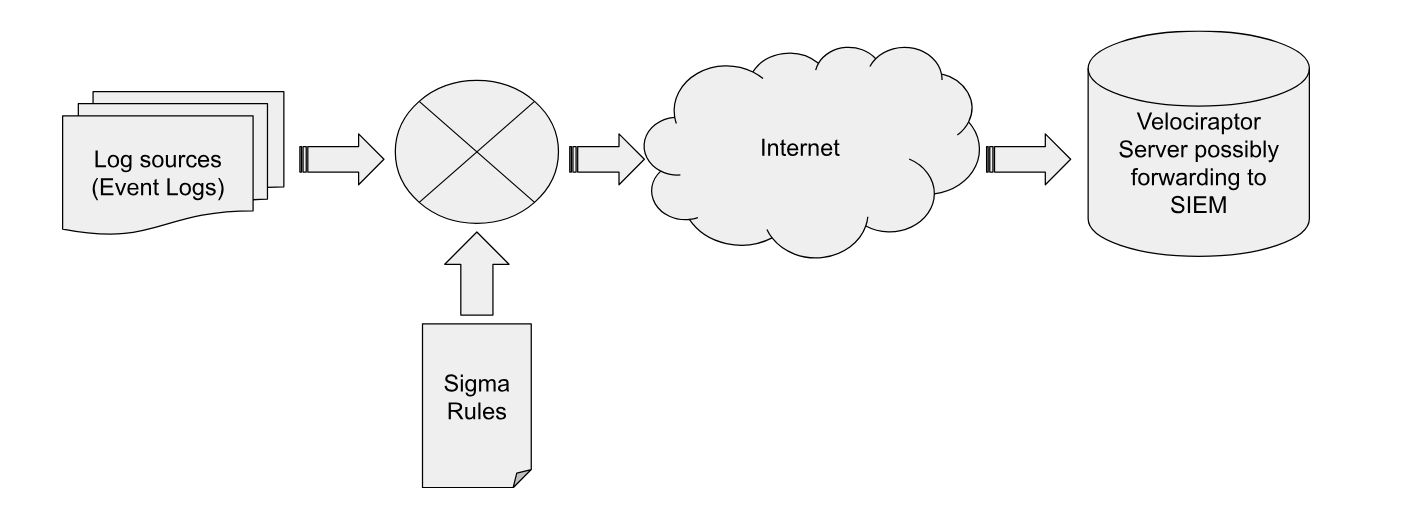
The above figure outlines the Velociraptor Sigma workflow:
- Sigma rules are synced to the endpoint via a Standard Velociraptor Collection and are applied to an internal Sigma rule matching engine.
- The engine determines which log sources will be used based on the actual rule requirement. Parsing additional log sources is easy to implement via a VQL query.
- Events are collected from the relevant local log sources (e.g. by parsing the relevant EVTX files) and are compared efficiently against the set of Sigma rules target each log source.
- Only matches are forwarded to the cloud (tagged by the Sigma rules by severity levels - e.g. Critical, High, Medium)
- The Velociraptor server only deals with high value events by writing to local storage or forwarding to a SIEM for alerting/escalation.
In this arrangement, the event volumes sent to the server are very small because only post-filtered events are handled.
The Sigma Velociraptor plugin
As explained above, Sigma is an abstract format which requires
implementations to provide a mapping between log sources and actual
concrete implementations of these sources. Before we can match any
Sigma rules in Velociraptor we need to teach Velociraptor how to map
between the log sources mentioned in a Sigma rule and a real VQL query
that will provide events from that source.
This mapping is created using the VQL sigma_log_sources()
function. The function receives a list of log source names and their
corresponding VQL queries.
For example, consider the following definition:
LET LogSources <= sigma_log_sources(
`*/windows/taskscheduler`={
SELECT * FROM parse_evtx(
filename=ROOT+"/Microsoft-Windows-TaskScheduler%4Operational.evtx")
},
)
When Velociraptor encounters the Sigma rule above it will look for a
defined log source with category=*, product=windows, service=taskscheduler forming the following key
*/windows/taskscheduler
The second mapping described above is between the rules mentioned in
the Sigma rule and the underlying fields in the actual
event. Velociraptor implements these mapping definitions via VQL Lambda functions.
For example consider the following field mapping definitions:
LET FieldMapping <= dict(
Path="x=>x.EventData.Path"
)
When Velociraptor attempts to evaluate a field mentioned in the Sigma rule, the Velociraptor Sigma engine will pass the event to this lambda function to resolve the actual field required. This allows us to implement any translation operation between Sigma fields and data based on the event itself - including more complex enrichment operators (more on that later!).
After defining the log sources and field mapping, we are ready to
match Sigma rules using the sigma() VQL
plugin.
This plugin receives a number of arguments:
rules: A list of sigma rules to compile and match.log_sources: A log source object as obtained from thesigma_log_sources()VQL function described above.field_mapping: A dict containing a mapping between a rule field name and a VQL Lambda to get the value of the field from the event.debug: If enabled we emit all match objects with description of what would match.rule_filter: If specified we use this callback to filter the rules for inclusion.Lambdadefault_details: If specified we use this callback to determine a details column if the sigma rule does not specify it.
For an example of a simple Sigma based artifact, See the
Windows.Sigma.EventLogs artifact
Managing a large repository of Sigma rules
The previous section described how Sigma rule matching is implemented in Velociraptor, but in practice we typically have a large number of Sigma rules, perhaps imported from external sources.
There are some challenges with Sigma and some rules are not written precisely enough to work in Velociraptor. For example, Sigma rules may reference non-existent log sources, or unknown fields that do not correspond to anything in the standard field mappings.
For this reason it is best to manage a large Sigma rule set using a
specialized tool velosigmac. You can find this tool at
https://sigma.velocidex.com or
https://github.com/Velocidex/velociraptor-sigma-rules
The repository already contains a large number of rules from the Sigma project as well as Hayabusa rules, but you can also add your own rules.
The velosigmac tool is controlled via a config file specifying the
various log sources and field mappings, and produces a zip file
containing a Velociraptor artifact.
You can import the curated Sigma rules automatically by collecting the
Server.Import.CuratedSigma server artifact.

Currently there are two types of curated artifacts:
- A Curated ruleset based on the Hayabusa rules. This artifact is a regular CLIENT type artifact that can be used to scan all EVTX files on the endpoint for rules matches.
- An Event based monitoring artifact that once installed follows all EVTX files to alert on Sigma rule matches in real time.
Sigma alerting via a CLIENT artifact
Velociraptor is not the only tool that can apply Sigma rules to a live system. Previously Velociraptor was integrated with Hayabusa, Chainsaw for quick triage using Sigma rules.
The ability to triage a system efficiently using Sigma rules allows first responders to quickly isolate the machines that need further investigation. In this regard the Sigma rules do not have to be perfect - they just need to indicate those machines requiring further work.
By applying a standard set of Sigma signatures to a large numbers of machines we can identify the interesting hosts quickly. An excellent demonstration of this technique can be seen in the Video Live Incident Response with Velociraptor where Eric Capuano uses the Hayabusa tool deployed via Velociraptor to quickly identify the attack techniques evident on the endpoint.
Now that Sigma is built into the Velociraptor engine itself, using these signatures is much more efficient. Simple collect the artifact imported earlier and collect it from the host in question, or start a hunt for all hosts.
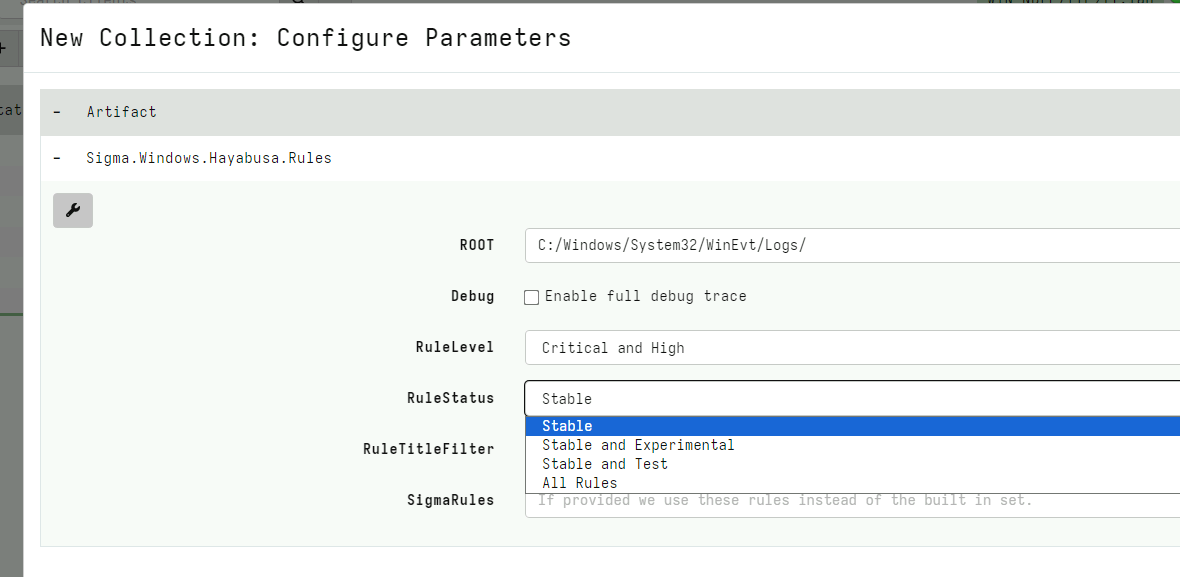
The artifact has a number of configurable settings:
RuleLevelspecifies which rules to include. Including lower level rules may detect interesting events but will also increase the false positive rate.RuleStatusspecifies which rule status to include - stable rules are more tested and less likely to produce false positives.
In the example below I collected Critical and High level rules. It
is instructive to see the query log:
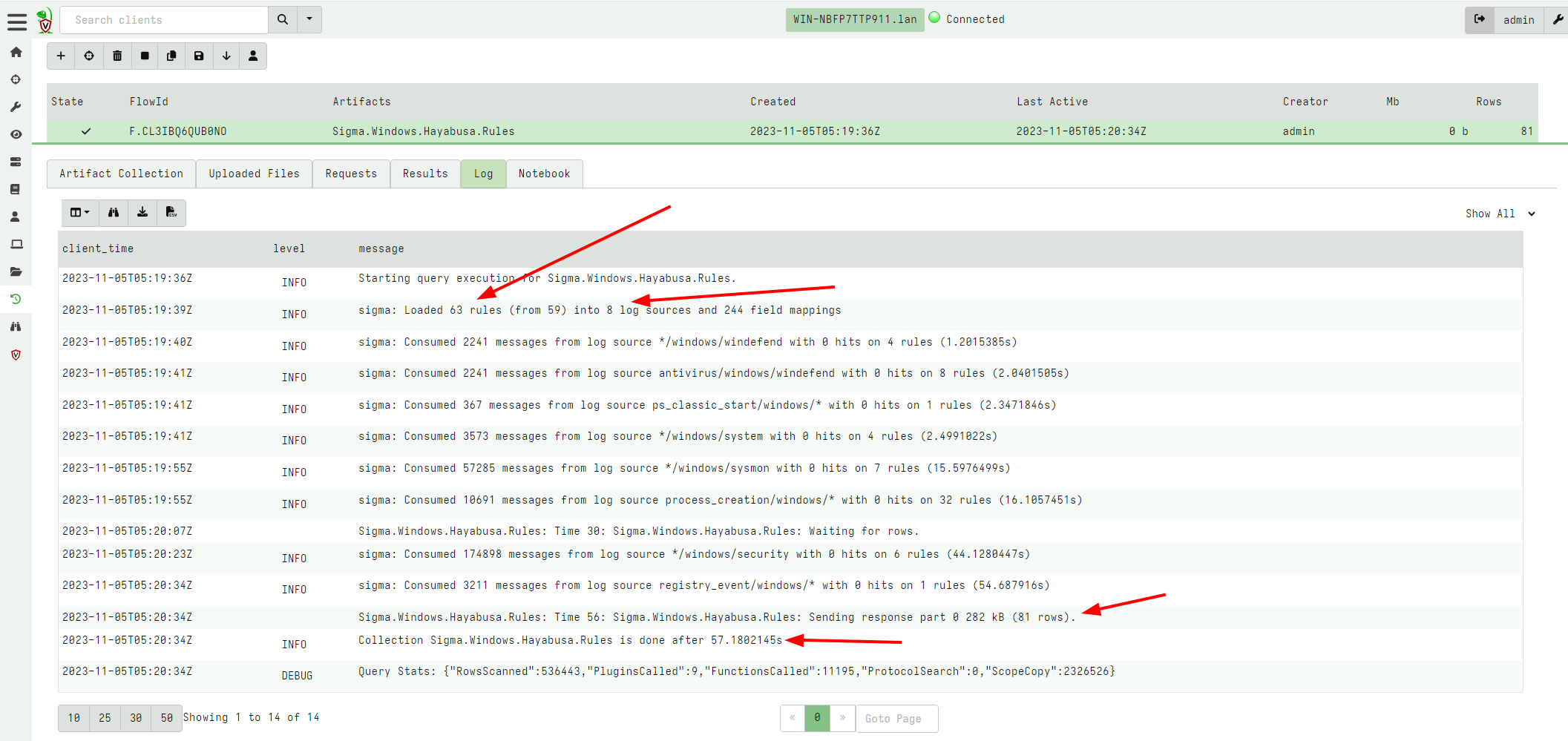
As can be seen the artifact selects 63 rules based on the Rule Level
and Status parameters. These rules end up referencing only 8 log
sources, so Velociraptor will only look at 8 log files - the largest
of these of these is the System log which contains 178k events.
Overall, Velociraptor found 81 hits on these Sigma rules in 57 seconds, and immediately we can see some critical information:

Let’s select All Rules with a status of Stable and Experimental
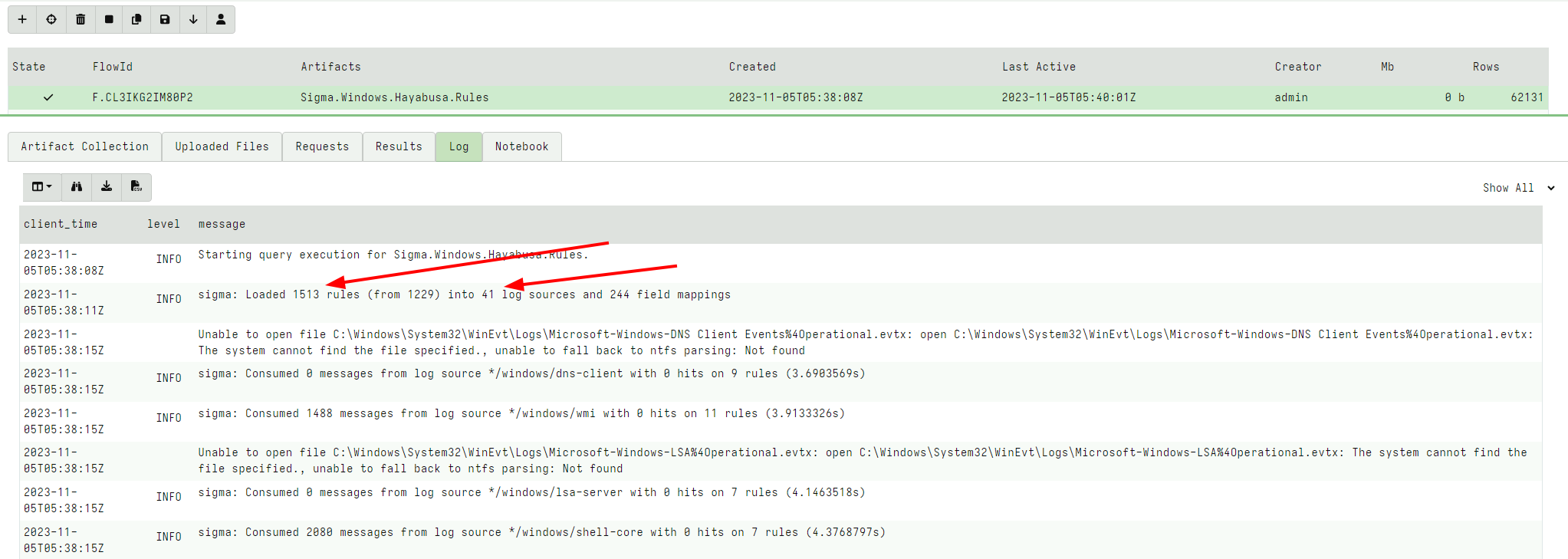
This time, there are 1500 rules matching 41 different log sources. The additional work required makes Velociraptor take 117 seconds now and it returns over 62 thousand hits!
The number of hits is too large to manually review, so I typically just want to know which rules were matched by stacking on the rule Title:
SELECT * FROM source(artifact="Sigma.Windows.Hayabusa.Rules")
GROUP BY Title
This reduces the number of rows to 62. I can immediately see interesting hits, even though they may be at low or informational level.
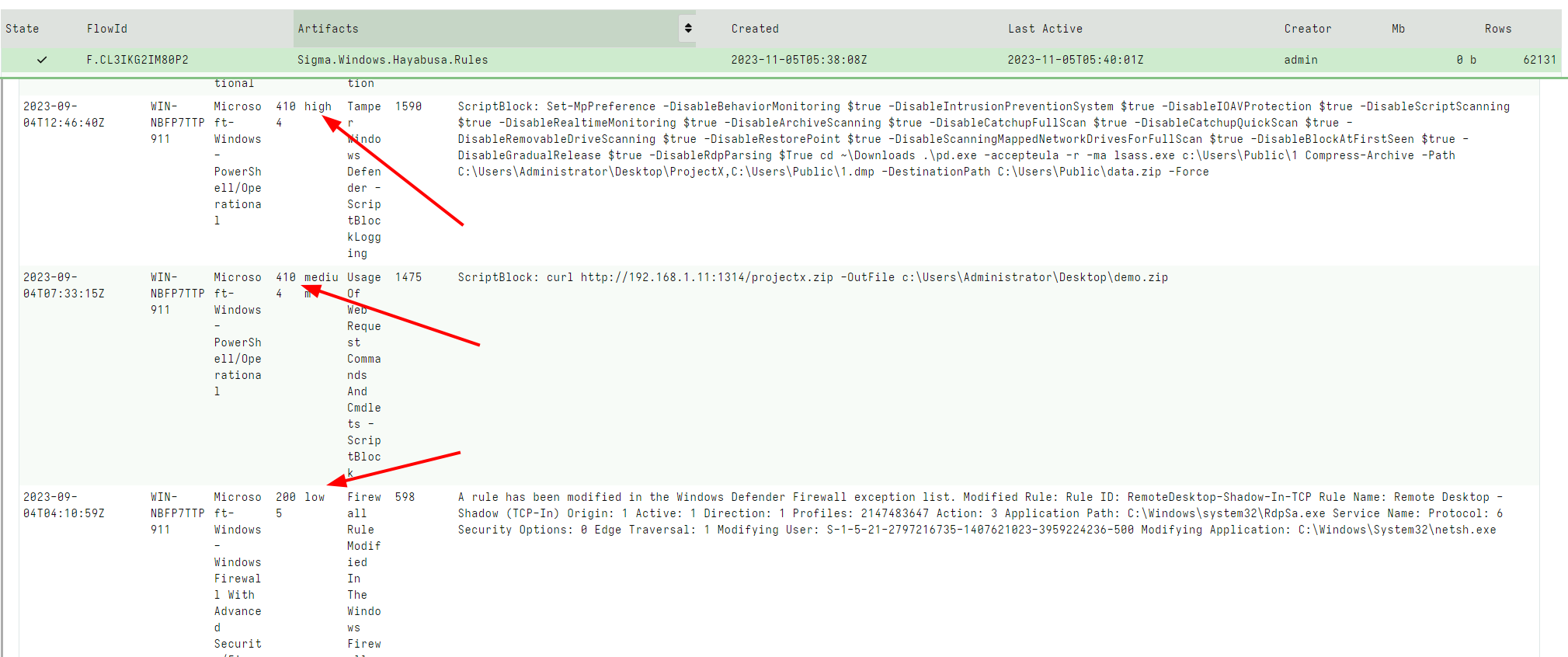
Typically for this type of collection, I tend to apply most of the rules because I can post process the hits later on the server, but you might want to collect only critical rules at first to reduce the amount of work the Velociraptor client needs to perform.
Using Sigma rules for rapid triage is a particularly attractive technique as shown above. Previously Velociraptor supported Sigma via pushing and launching the Hayabusa tool to the endpoint, and collecting the results from it.
So what advantages are there for natively supporting Sigma withing Velociraptor?
By supporting the rules natively, we can control execution more closely. In particular, Velociraptor’s CPU and memory controls can only work when Velociraptor itself is doing the work. By shelling out to an external tool we have no control over how many resources Hayabusa is using on the endpoint. Having Sigma as a built in capability allows Velociraptor to limit CPU utilization in order to minimize the impact on the endpoint.
Velociraptor is much more efficient than Hayabusa. Typically Velociraptor can match the same number of rules approximately 5 times faster. However, the most important difference is the much reduced memory requirements. In my testing, Hayabusa typically uses about 1-2Gb of memory on the endpoint vs. about 200-300mb used by Velociraptor, making Hayabusa too risky to deploy very widely.

Sigma alerting via real time monitoring artifacts
Velociraptor’s VQL queries are streaming queries. This means they
deliver rows as soon as they become available, while the query itself
does not have to terminate. This facility is called Client Monitoring or Event
queries.
Since the built-in Sigma matching engine is also streaming and asynchronous, it is also possible to use event queries for log sources.
The Velociraptor Hayabusa Live Detection option in the Curated
import artifact will import an event monitoring version of the same
curated Sigma rules. I can configure the artifact in the usual way.
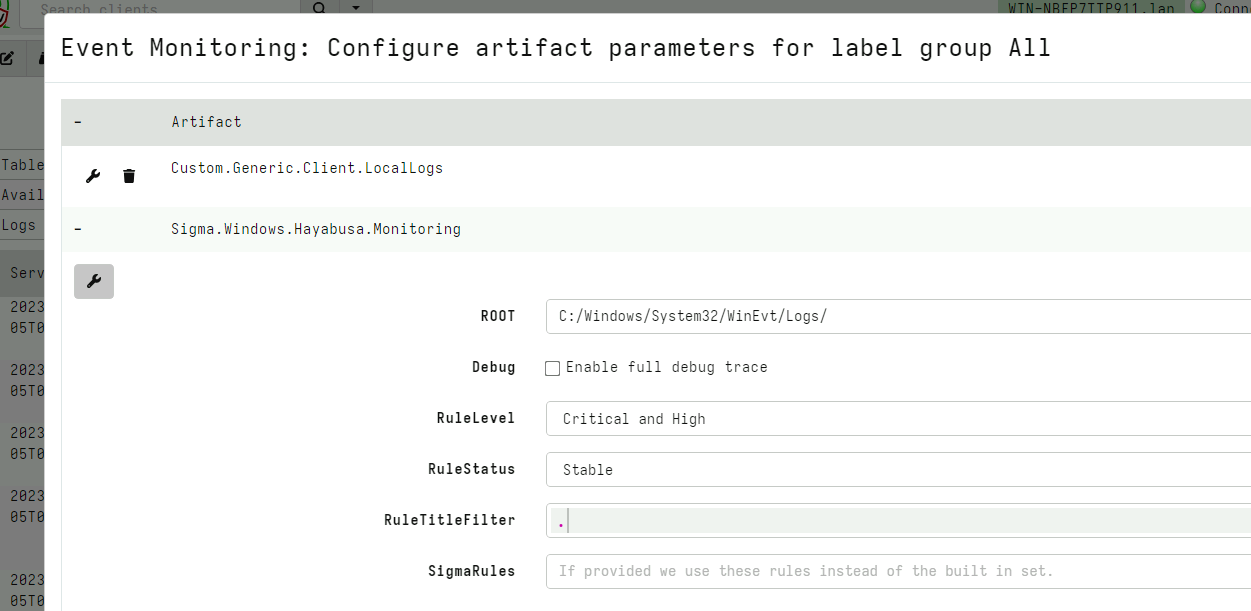
This time the endpoint will forward detection events to the server in real time.

In the above I can see immediately suspicious use of PSExec in real
time!
Conclusions
While Sigma itself is not a matching engine, it presents a convenient abstraction over other matching engines. Integrating a Sigma matching engine within Velociraptor allows users to add easy to read and maintainable rules specifically designed for detection. The built in Sigma matching engine is extremely fast while being built on top of VQL.
This makes is flexible - it is possible to add arbitrary logs sources from any VQL query. For example log sources based on ETW are already in the works. This engine can efficiently match thousands of rules on the endpoint, either in real time, or from historical sources.
Sigma presents a lot of opportunities to extend the detection capabilities when running directly on the endpoint. Unlike using Sigma as an interface to a SIEM where we are really at the mercy of the log sources and fields that are forwarded by the collection agent and the SIEM, Sigma rules on the endpoint can refer to any log source - be it an event log or other more traditional sources of evidence, such as Volatile information like process information, registry keys or networking information.